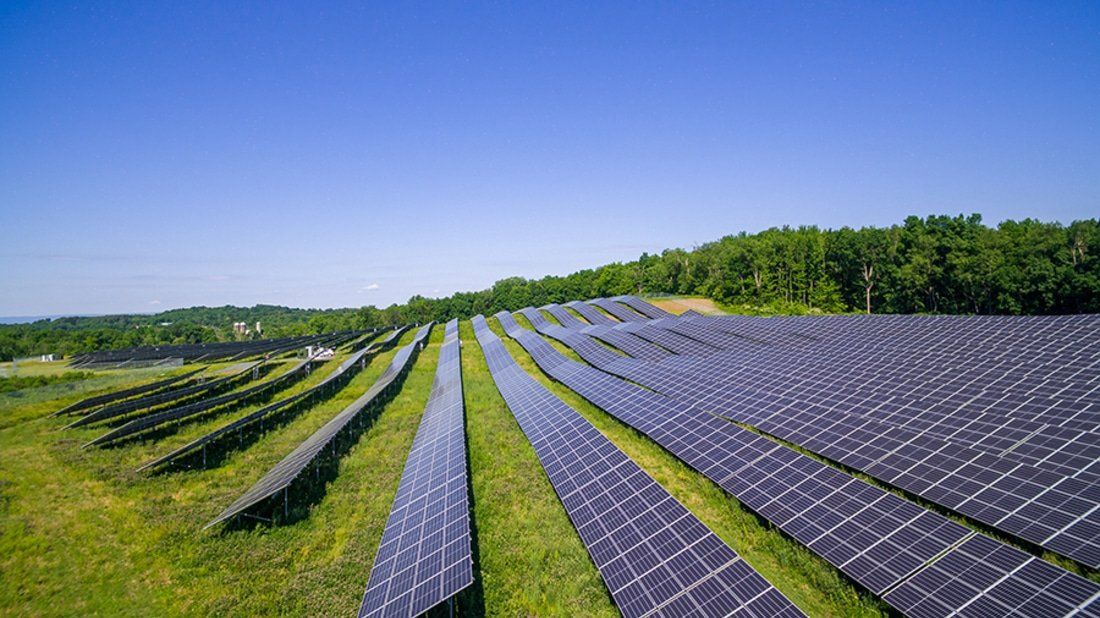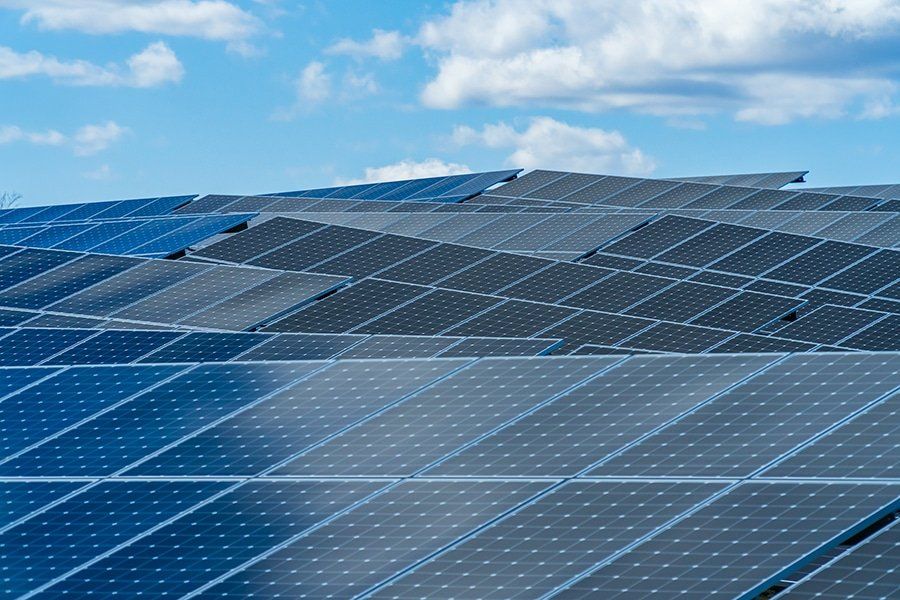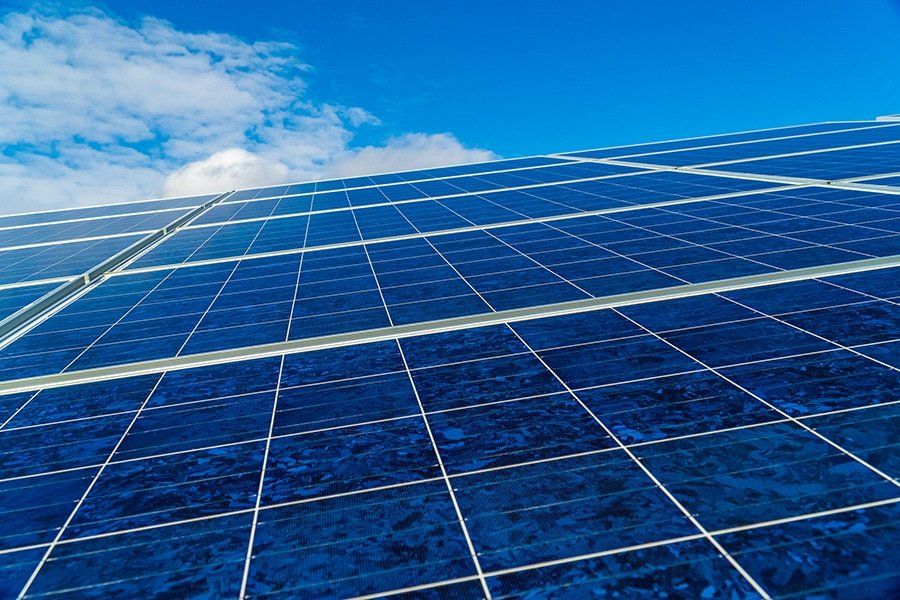
By now, most homeowners, businesses, and even renters are aware of the environmental and financial benefits solar power has to offer. Even better, solar technology has dramatically improved over the years, bringing forth a range of innovative solar panels to the market. There are three different types of solar panels available in the market. The most common types are:
1. Monocrystalline Solar Panels
2. Polycrystalline Solar Panels
3. Thin Film Solar Panels
Monocrystalline solar panels
Monocrystalline solar panels are the most commonly used residential solar panel to date because of their power capacity and efficiency. Monocrystalline solar panels can reach efficiencies higher than 20%, making them the most efficient panel on the market. While 20% may not sound impressive, there’s a reason behind it. The sun’s rays span a broad spectrum of wavelengths and depending on the characteristics of the semiconductors and design of a solar cell, some of that light can be reflected, passed through, and eventually absorbed and converted into electricity. For this reason, researchers are focusing on figuring out how to design more efficient conductors for solar panels.

One of the easiest ways to identify a monocrystalline solar panel is by its color. The cells on a module typically appear black to the eye because of how light interacts with its high-quality silicon, making it function well in low-light conditions. For this reason, they are more efficient as black surfaces absorb light more easily. They also tend to generate more power than other types of panels, not only because of their efficiency but because they come in higher-wattage modules with more than 300 watts of power capacity. Most individuals enjoy the sleeker aesthetics of monocrystalline solar panels on their roof for this factor, as they blend in well with black roof shingles. While efficiency and appearance make it a better selling point, they tend to be more expensive in part due to their manufacturing process.
Polycrystalline solar panels
Polycrystalline solar panels have been around for quite some time and are common among many individuals looking to go solar on a budget. These types of solar panels usually have efficiencies between 15% to 17%. While they aren’t as efficient as their counterpart monocrystalline, their advantage is their price point. The reason being is that the cells are produced from many silicon fragments, hence “poly”, rather than a single pure silicon crystal that’s used in monocrystalline cells. This allows for a simpler cell manufacturing process, therefore making it more cost-efficient to the end user.

A polycrystalline panel’s blue hues come from the anti-reflective coating that helps improve the absorbed capacity and efficiency of the solar panel.
Thin film solar panels
Thin film solar panels tend to have lower efficiencies and power capacities than monocrystalline and polycrystalline panels. While efficiency can vary based on the certain material used in the solar cells, they usually lean more towards an efficiency of 11%. Lower efficiency ratings mean more thin film solar panels that would need to be installed in order to produce the same amount of electricity as a monocrystalline or polycrystalline solar system. For this reason, thin film solar panels might not be the best option for residential solar. On the other hand, they make the most sense in larger-scale installations like utility-scale solar projects, as more panels can be installed to meet energy demands.

Thin film solar panels are made with solar cells that have light-absorbing layers about 350 times smaller than the average silicon panel, making them very flexible. They come in both blue and black hues, depending on what they are made of. The most predominant type of thin film solar panel is made from cadmium telluride but they can also be made from amorphous silicon, which is similar to the composition of mono and polycrystalline panels, and copper indium gallium selenide. As far as cost goes, what you pay for thin film panels will largely depend on what exactly they are made from, but overall, the cost of a thin film solar panel installation tends to be lower than installing a monocrystalline or polycrystalline system.
Composition of the Different Types of Solar Panels, Explained
The first type is the monocrystalline solar panel, which uses a single piece of pure silicon cut into several wafers. Pure silicon is the best form of the crystal, which gives monocrystalline panels excellent durability and space efficiency. However, the drawback is that the production process tends to use pure silicon. The result is that you’ll get a higher price tag with monocrystalline vs. polycrystalline solar panels.
In contrast, polycrystalline panels use many different pieces of silicon crystals. These are then melted together to form a single panel. The main benefit of this process is that no silicon is wasted, which keeps costs relatively cheaper. But there’s a tradeoff. The energy efficiency and heat tolerance are significantly lower with polycrystalline vs. monocrystalline panels. That means they produce less energy overall.
Finally, thin-film solar panels are made from different kinds of materials entirely. These are often copper indium gallium selenide (CIGS), amorphous silicon (a-SI), or cadmium telluride (CdTe). A-SI tends to be the cheapest and most inefficient among the three types, while CIGS tends to have the best efficiency.
What is the Capacity of Each of the Different Solar Panels?
Monocrystalline panels have the highest output and power capacity, thanks to their higher efficiency per square foot. Expect a standard 60-cell solar panel to produce 310W – 350W on average. Surprisingly, polycrystalline panels aren’t that far behind. The average capacity for a 60-cell panel of this type is around 250W – 300W.
The capacity of thin-film panels, on the other hand, is harder to generalize, thanks to differing sizes. But as a rule of thumb, they output less wattage overall than crystalline panels. As a sample comparison, a high-efficiency CIGS panel peaks at 250W, which is at the lower end of the polycrystalline range.
What is the Efficiency Based on the Solar Panel’s Type?
Monocrystalline panels have the highest efficiency rating of any type of solar panel, reaching over 20%. This means that these can convert 20% of sunlight into usable energy. Polycrystalline panels are within the average range, hitting around 15% – 17%. For most residential purposes, these figures would suffice.
Thin-film panels, in contrast, have an overall efficiency rating compared to silicon crystalline panels. CIGS, the best among the three, tops at 13% – 15%. CdTe is in the middle with 9% – 11%. a-SI has the worst efficiency at 6% – 8%, which is why it’s often used for low-power applications like solar calculators.
What are the Costs of the Three Different Solar Panels?
Because of their energy and space efficiency, monocrystalline panels fetch the highest prices. Their cost ranges from $1 – $1.50 per watt, which means a 350-watt panel will set you back $350 – $525.
Polycrystalline panels represent an excellent price-to-efficiency ratio. They cost around $0.90 – $1 per watt, which translates to $315 – $350 for a 350-watt panel. It might not seem like a hefty price drop, but the savings add up when buying 20+ panels.
Thin-film panels, as a whole, have a price range between $0.50 to $1 per watt. CIGS tends to command the higher end of this price range.
What Type of Solar Panel is Best?
The best solar panel type for your needs depends on a few factors, including the size and weight of roofs. If you have limited space or need high efficiency per square foot in order to save money monocrystalline panels will be perfect!
The opposite is true if you have a larger property, such as a commercial building or a farm. At a high enough square footage, the lower efficiency of a polycrystalline panel can be traded off with cheaper installation costs, allowing you to install more panels to compensate for the output loss.
Thin-film panels are good alternatives when a crystalline silicon panel isn’t feasible. Good examples include thin buildings roofs or the compact top of RVs. They’re also great options for hotter environments, thanks to a higher temperature coefficient (more on this later).
However, note that the cost of the panel itself isn’t the only factor to consider. You should also look at labor and maintenance costs to get a complete picture of which type is best for you.
Factors Affecting Solar Panel Models
Heat tolerance is one of the main things that can affect the efficiency of a solar panel. This is measured with the panel’s temperature coefficient or the output drop for every degree of temperature increase. This is where thin-film panels have an edge, with an output loss of only 0.2% compared to around 0.3% – 0.5% of crystalline panels.
Weather resistance is also a crucial factor. For colder climates, hail resistance is especially important. Crystalline panels are generally more resistant, while thin-film panels are more susceptible to hail damage.You should also be aware of light-induced degradation or LID. This phenomenon introduces a temporary performance drop during the first hours of exposure to sunlight due to oxygen from the production process. Generally, this is at around 1% – 3% output loss.
What types of solar panels does Nexamp use?
At Nexamp, we build, own and operate our solar farms and manage the process from start to finish. Our farms come in different shapes, sizes, and panels. While we use both monocrystalline and polycrystalline solar panels on our projects, our top priority is to keep our assets operating at 100% at all times, and we remain confident that our solar farms will generate power to provide clean energy savings to our subscribers.
The aesthetics of rooftop solar can sometimes be a hurdle when it comes to individuals making the switch to solar. And for some, rooftop solar might not be an option at all if they don’t have the right roof, don’t own a home, or simply find the installation prices too high. Community solar programs are a common way for many homeowners, businesses and even renters to go solar without actually installing anything on their roof. Participants can subscribe to a nearby solar farm and pay a lower price for the electricity sourced from it.
Installing either monocrystalline, polycrystalline, thin film solar panels, or subscribing to a community solar farm will help you reduce your electricity costs, while supporting the transition to a decarbonized future. Consider your needs and budget when determining the best option for your home and lifestyle. To discuss your eligibility to one of our community solar farms, contact us today!